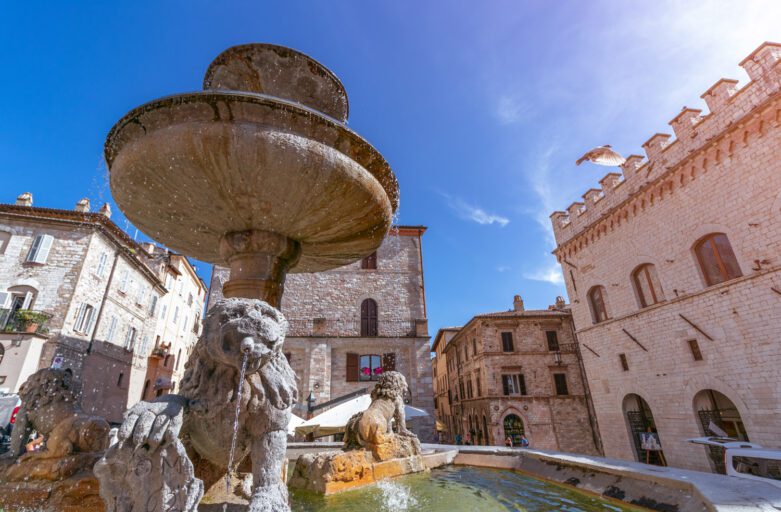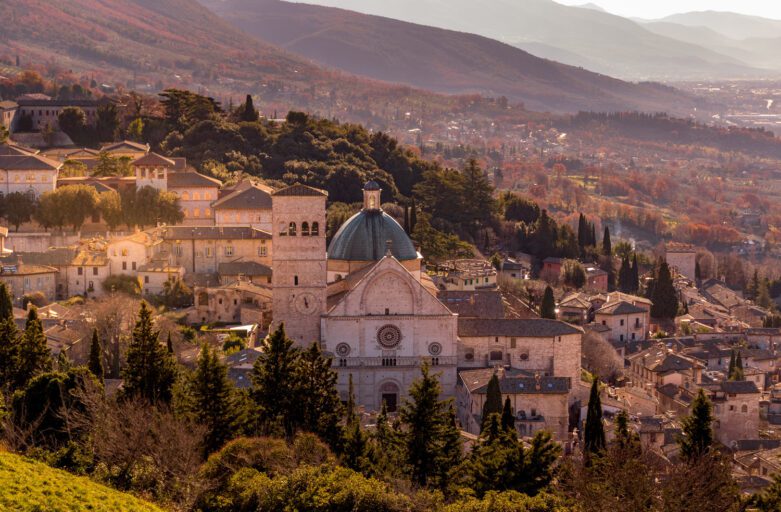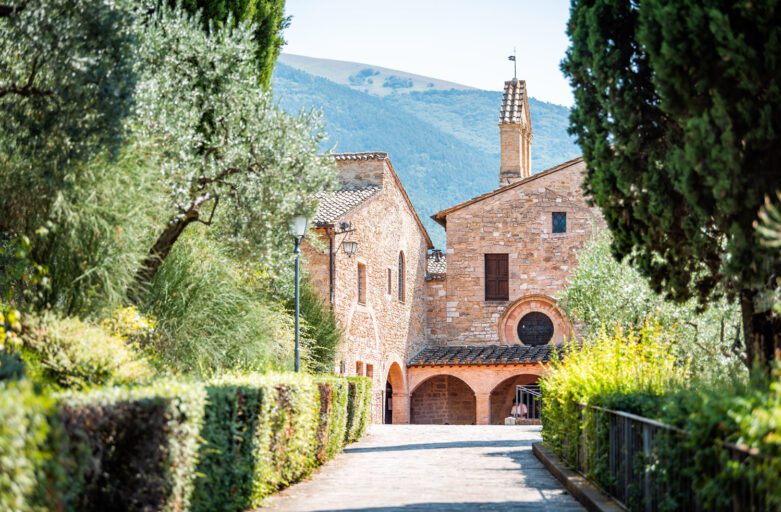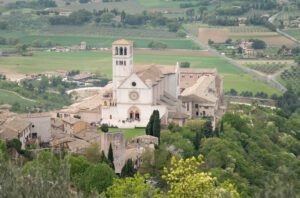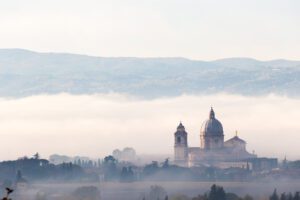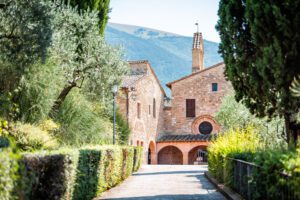The Main Square in Assisi
Piazza del Comune (the town hall square) has always been the hub of social and cultural life in Assisi. Not by chance do all the main streets from the town gates meet here.
Built upon a Roman forum, in the Middle Ages it became the place for the people's gatherings. Therefore, here rise the most important buildings of town life: the Temple of Minerva, also used as the oldest Town Hall in Assisi (later transferred to Palazzo dei Priori, the palace of Medieval “priors”); the palace of the Capitano del popolo (the “common people's” – actually, the middle class' – political spokesman), and the People's Tower.
So, by standing in the center of the square and turning around, you will be able to “read” the whole history of the town through the different eras, following and crossing one another.
The Roman Period
The Forum
Once in the square, the first thing you may want to do is looking – below it.
The ancient Roman forum (one reaches it immediately before entering the square proper) was rediscovered in 1836. It still includes the temple basement, a small four-pillared temple dedicated to Castor and Pollux, a monumental cistern, and a platform with the seats for the Roman magistrates.
The Temple of Minerva
Lifting your eyes, you will then see the Temple of Minerva, whose six Corinthian pillars and façade have been perfectly preserved.
The church reusing the room of the old temple is dedicated to Holy Mary, the heavenly queen of Christian wisdom, instead of Minerva, who was the goddess of pagan wisdom. Anyway, the modern name Santa Maria sopra Minerva, “Holy Mary upon/above Minerva” (i.e., replacing her role and temple) is much less frequently used than the older name, probably because the original architecture is still well recognizable.
In spite of having been so well preserved, the temple had no peaceful history at all, it underwent all sort of events along with the Roman Empire, glory days to decadence.
Enter the Benedictine Monks
After the end of paganism, the temple remained forlorn for more than a century; then, in the second half of the sixth century AD, the Benedictine monks restored it. They divided it into two areas, making the Church of Saint Donato out of the lower part of it, and some rooms out of the upper part.
In 1212 the monks rented a section of the former temple to the newly created Assisi town hall; here the Medieval magistrates transferred their offices. For almost two centuries, the courthouse would have its seat in the former temple pronaos, while the former Church of Saint Donato was now used as a jail.
In 1539, Pope Paul III ordered to restore the temple and dedicate it to Virgin Mary. More restorations, in a Baroque style, were made in the 17th century after the building had been given to the friars of the Third Order Regular of Saint Francis.
The Middle Ages
Tower and Palace of the Capitano del popolo
On the left of the temple you will notice the People's Tower, 47 meters (154 feet) high. It was completed in 1305, and used as a lodging for the Capitano del popolo.
In 1501, the rooms at the first floor were given to the College of Notaries. In 1531, Paolo di Jacopo, a wood craftsman from Gubbio made the doors imitating those at the Collegio del Cambio (College of the Exchange) in Perugia.
The architectural crowning with apparently Medieval Ghibelline merlons was made no sooner than 1926, for the seven-hundredth anniversary of Saint Francis' death.
Keeping shifting one's eyes, one will meet the Palace of the Capitano del popolo. It was the first political building newly built in the square, having been completed in 1282 in order to house the office of the Capitano del popolo
People's Palace and Palace of the Priors
By turning your back on the Temple of Minerva, you can see other two fundamental buildings for Medieval communal society. Firstly, the People's Palace (where “people” meant merchants, etc.), chosen by the Town Hall as the place for the meetings of the People's General Council. It was completed about 1308, after the square itself had been enlarged in 1275.
A vault links the People's Palace with another building, namely the one the priors bought in 1337; it would become the Palace of Priors. When, at the National Unification in 1860, Assisi was annexed to the Savoy State, the old palace underwent major restorations, and was turned into the current Town Hall. The Assisi Town Hall offices are still housed here.
The Renaissance
Bonacquisti Palace
In spite of its not quite vast size, the square has room enough for some Renaissance buildings too. Bonacquisti Palace is an important building dating back to the 16th century, with decorated ceilings and ancient walls. It belonged to the noble Bonacquisti family, lords of Panzo (an area one mile off Assisi).
The Fountain of the Three Lions
For a square so central in town life, it was impossible that it may lack a fountain: a spot par excellence where the people used to meet, in fact a key element in Medieval squares throughout Italy. It appears first mentioned as simply the “fountain in the square” or Fountain of the Three Lions in 1303. Later on, it would be rebuilt twice: in 1467 by Polimante di Maestro Gentile, with stone slabs and little pillars; in 1772 by Giuseppe Martinucci, a stone-cutter from Assisi.
The fountain's name comes from the three stone lions, the symbols of the town rioni (the Medieval quarters). The lower basin has a perimeter with nine sides; a central baluster supports the second basin, which in its turn has a baluster with a pine cone
Some curious facts
Town Hall Square in a “photo” by Giotto
Among Giotto's frescoes on Saint Francis' life, one shows “The tribute of the simple man”: a man from Assisi, having noticed Francis who was passing by, spreads his own garments before the Saint to honor him. The episode takes place in Town Hall Square, that is clearly recognizable. Nowadays it may even seem trivial to have the urban landscape rendered in “photographic” detail, but it was not so at that time. As a matter of fact, this is one of the very first works of art in which the town does not simply provide a setting, but is actually part of the narrative: the town hall square “as was” when Saint Francis crossed it.
Calendimaggio
Every year in May, in Town Hall Square a festival takes place, whose origins are lost in the past: the Calendimaggio. It is noteworthy to remark that, for the Assisi citizens, it is not simply about a recreation of something that happened in history. In fact, the contest between the two town Parts – the Nobilissima Parte de Sopra (Most Noble Upper Part) and the Magnifica Parte de Sotto (Magnificent Lower Part) – never ceased to excite all inhabitants. The festival has also been proposed as a candidate for the UNESCO Intangible Cultural Heritage List.
INFORMAZIONI
Località
Piazza Cahen, 5B, 05018 Orvieto TR
Orari
Giugno-Agosto: tutti i giorni 9:00-20:00
1-22 Settembre: tutti i giorni 9:00-19:00
5-11 Ottobre: tutti i giorni 9:00-19:00
12-19 Ottobre chiuso per lavori di manutenzione.
Dal 20 ottobre: tutti i giorni dalle 9:00-19:00
La biglietteria chiude 45 minuti prima dell’orario di chiusura.
Contatti
Email: info@genesiagency.it
